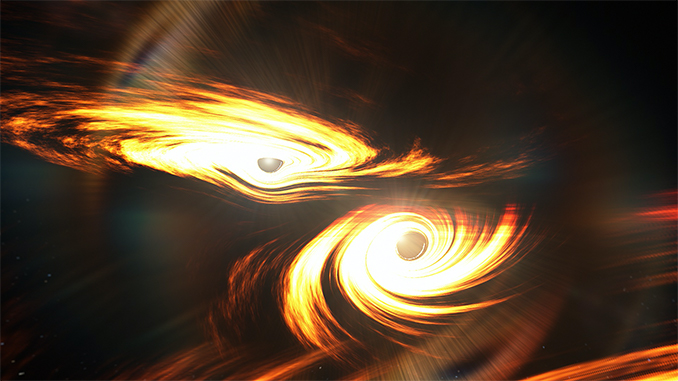
The LIGO and VIRGO gravitational wave observatories have detected ripples in space-time lasting just a tenth of a second that indicate the merger of two black holes with 85 and 65 solar masses. The result was a single black hole with 142 times the Sun’s mass, the first direct evidence of an intermediate-mass black hole, one that weighs in at 100 and 100,000 solar masses.
While multiple black hole mergers have been detected by gravitational waves since the first was observed in 2015, the 142-solar-mass hole in this case – GW190521 – is the most massive and most distant yet found. Eight solar masses were converted into energy in the collision, creating the gravitational waves that reached Earth on 21 May 2019, seven billion years after the fact.
“Right from the beginning this signal, which is only a tenth of a second long, challenged us in identifying its origin,” said Alessandra Buonanno, director at the Max Planck Institute for Gravitational Physics (Albert Einstein Institute; AEI) in Potsdam and College Park professor at the University of Maryland.
“But, despite its very short duration, we were able to match the signal to one expected of black-hole mergers, as predicted by Einstein’s theory of general relativity, and we realised we had witnessed, for the first time, the birth of an intermediate-mass black hole from a black-hole parent that most probably was born from an earlier binary merger.”
Said Virgo member Nelson Christensen, a researcher at the French National Centre for Scientific Research: “This doesn’t look much like a chirp, which is what we typically detect. This is more like something that goes ‘bang,’ and it’s the most massive signal LIGO and Virgo have seen.”
The LIGO and VIRGO collaborations reported the observation in the journals Physical Review Letters and Astrophysical Journal Letters.
Stellar mass black holes form when a massive star runs out of nuclear fuel. Fusion reactions suddenly stop, ending the outward pressure needed to balance the inward pull of gravity. The core then collapses to extreme density, overcoming quantum effects that would halt the collapse of a lighter star. The result is a stellar-mass black hole.
At the other extreme are the supermassive black holes at the hearts of large galaxies with masses millions to billions greater than the Sun. A major question is how do supermassive black holes form, and are intermediate-mass black holes a stepping stone of some sort?
“One of the great mysteries in astrophysics is how do supermassive black holes form? They are the million solar-mass elephants in the room,” said Christopher Berry, a researcher at Northwestern University’s Center for Interdisciplinary Exploration and Research in Astrophysics.
“Do they grow from stellar-mass black holes, which are born when a star collapses, or are they born via an undiscovered means? Long have we searched for an intermediate-mass black hole to bridge the gap between stellar-mass and supermassive black holes. Now, we have proof that intermediate-mass black holes do exist.”

Current theory holds that black holes with masses in the approximate range of 65 to 120 solar masses cannot form from the collapse of a single star. Theory holds that dying stars in that mass range would blow themselves completely apart.
While uncertainties might allow for black holes with more than 65 solar masses to form in supernova explosions, that is not the case for the larger 85-solar mass black hole that merged to form GW190521.
“From our understanding of how stars age and evolve we expect to find black holes with either less than 65 solar masses or more than 120 solar masses, but none in between,” said Frank Ohme, leader of an Independent Max Planck Research Group at AEI Hannover. “The 85 solar-mass black hole in the GW190521 origin system falls right in that gap where it shouldn’t be.
“This can mean two things: our understanding of stars’ evolution is incomplete or something different has happened here.”
The 85-solar-mass black hole likely is the result of earlier mergers between smaller black holes, but it’s also possible it could have been a primordial black hole formed in the Big Bang. Either way, the merger marked the most powerful gravitational wave event yet detected.



